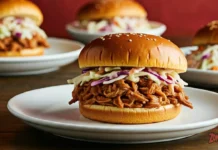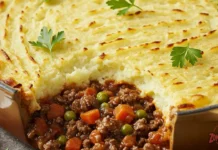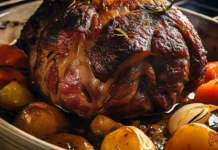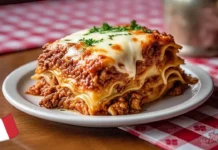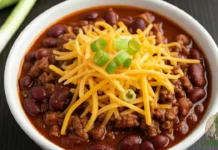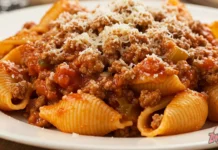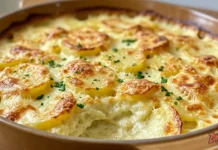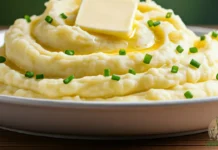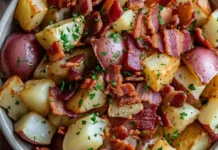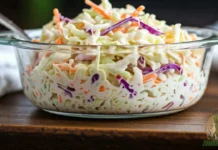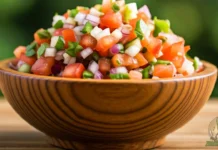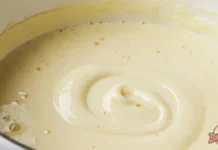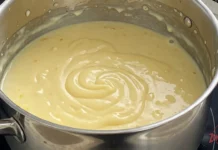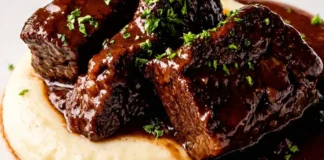



Bolognese sauce, known as “Ragù alla Bolognese” in Italian, is a meat-based pasta sauce originating from Bologna, Italy. This rich and flavorful sauce is a staple of Italian cuisine and has become a popular favorite worldwide. This hearty sauce is a staple in Italian cuisine and is typically served with pasta or lasagna. Whether you’re a seasoned chef or a home cook, mastering an authentic Bolognese sauce recipe will elevate your culinary repertoire.
History and Origins
The origins of Bolognese sauce date back to the late 18th century in Bologna, Italy. The sauce was initially called “Ragù” and was made with ground meat, tomatoes and onions. Over time, the recipe evolved, and the name changed to “Ragù alla Bolognese.” In 1982, the Accademia Italiana della Cucina (Italian Academy of Cuisine) officially registered the recipe, solidifying its place in Italian culinary tradition.
Ingredients for Bolognese Sauce
- Ground Beef (500g): For a rich and meaty flavor. You can also mix with ground pork for extra depth.
- ¼ lb (115g) pancetta or bacon: finely chopped (optional but recommended)
- Carrots (2, finely chopped): Adds sweetness and texture to the sauce.
- Celery Stalks (2, finely chopped): Provides a subtle earthiness.
- Onion (1 large, finely chopped): Essential for the aromatic base.
- Garlic (3 cloves, minced): Infuses the sauce with a warm, savory aroma.
- Tomato Paste (2 tablespoons): Concentrated tomato flavor that thickens the sauce.
- Crushed Tomatoes (800g): Forms the tomato base of the sauce.
- Dry White Wine (1 cup): Enhances the sauce with a slightly acidic balance.
- Vegetables Stock (1 cup).
- Whole Milk (1 cup): Creates a creamy texture and mellows the acidity of tomatoes.
- Olive Oil (2 tablespoons): For sautéing the vegetables and meat.
- Salt and Pepper: To taste.
- Parmesan Cheese (grated, for serving): Optional, but highly recommended for garnish.
Instructions to Make Bolognese Sauce

- Preparation: Begin by finely chopping the carrots, celery, and onion. Mince the garlic cloves. Having your ingredients prepped will make the cooking process seamless.

2. Sauté Vegetables: In a large pot or Dutch oven, heat the olive oil over medium heat. Add pancetta (if using), cooking until slightly crispy. Add the chopped carrots, celery, and onion. Sauté until the vegetables are softened, about 8-10 minutes. Add the minced garlic and cook for an additional minute until fragrant.
3. Brown the Meat: Increase the heat to medium-high and add the ground beef (and pork if using). Cook until the meat is browned and cooked through, breaking it up with a spoon to ensure even cooking. This should take about 10 minutes.

4. Deglaze and Simmer: Pour in the white or red wine into the pot, scraping up any browned bits from the bottom of the pot. Let it simmer for 5 minutes until the alcohol evaporates. Add the crushed tomatoes, tomato puree, and vegetables stock (or water). Reduce heat to low, cover the pot, and simmer for 1 hour.

5. Incorporate Milk: Add the milk and simmer on low heat for another 1 hour or until the sauce has thickened and the flavors have melded. Season with salt and pepper to taste. Stir occasionally and add a splash of broth or water if it thickens too much.
6. Cook the Pasta: About 15 minutes before serving, cook your pasta in a large pot of salted boiling water according to package instructions. Drain, reserving a cup of pasta water.

7. Finish and Serve: Toss the cooked pasta with the Bolognese sauce, adding a splash of pasta water to loosen it if needed. Garnish with a generous sprinkle of Parmesan cheese.
Nutritional Information (One serving of Bolognese sauce (without pasta) provides approximately) Calories: 300-Protein: 20g-Fat: 15g-Carbohydrates: 10g
Tips for Perfect Bolognese Sauce
- Choose the Right Pasta: While spaghetti is popular, wide, flat noodles like tagliatelle are traditionally paired with Bolognese sauce to hold the rich meat sauce better.
- Use Quality Ingredients: Fresh vegetables, good quality meat, and authentic Italian tomatoes (San Marzano or similar tomatoes) make a big difference in taste.
- Use a mix of meats: Beef, pork, and pancetta add complexity.
- Don’t Rush the Simmer: The longer the sauce cooks, the better it tastes. If you’re short on time, a minimum of 1.5 hours will still work.
- Don’t skip the milk: It tenderizes the meat and balances acidity.
- Experiment with spices: Add nutmeg, cinnamon or other spices for added depth.
- Make It Ahead: Bolognese sauce tastes even better the next day. Prepare it in advance and reheat for maximum flavor.
Variations of Bolognese Sauce
While the traditional recipe is unbeatable, you can experiment with different variations to suit your taste:
- Use different meats: You can substitute other ground meats such as veal or lamb for a different flavor profile.
- Vegetarian Bolognese: Replace the meat with lentils, mushrooms, or plant-based ground meat for a vegetarian twist.
- Gluten-Free Option: Serve with gluten-free pasta or zucchini noodles.
- Spicy Bolognese: Add a pinch of red pepper flakes or a diced chili for a spicy kick.
- Bolognese with Sausage: Mix in Italian sausage for added flavor.
- Creamier Version: Stir in a splash of heavy cream at the end of cooking for a richer texture.
- White Bolognese: Use ground pork, garlic and cream for a creamy variation.
Storing and Reheating
Bolognese sauce can be refrigerated in an airtight container for up to 5 days or frozen for up to 3 months. Reheat it gently on the stovetop, adding a bit of water or stock to restore its consistency.
Frequently Asked Questions (FAQs)
- What’s the difference between Bolognese and regular meat sauce?
Bolognese is milk-infused, wine-based, and slow-cooked, while American-style meat sauce is usually tomato-heavy and quicker to make. - Can I use ground turkey or chicken? While traditional Bolognese uses beef and pork, you can certainly substitute ground turkey or chicken.
- Can I make Bolognese in a slow cooker?
Yes! After browning the meat, transfer everything to a slow cooker and cook on low for 6-8 hours. - Why is my Bolognese sauce too acidic?
Balance acidity by adding a pinch of sugar, more milk, or a grated carrot. - What pasta is best for Bolognese?
Tagliatelle, pappardelle, or fettuccine are ideal—their wide shape holds the sauce well.

